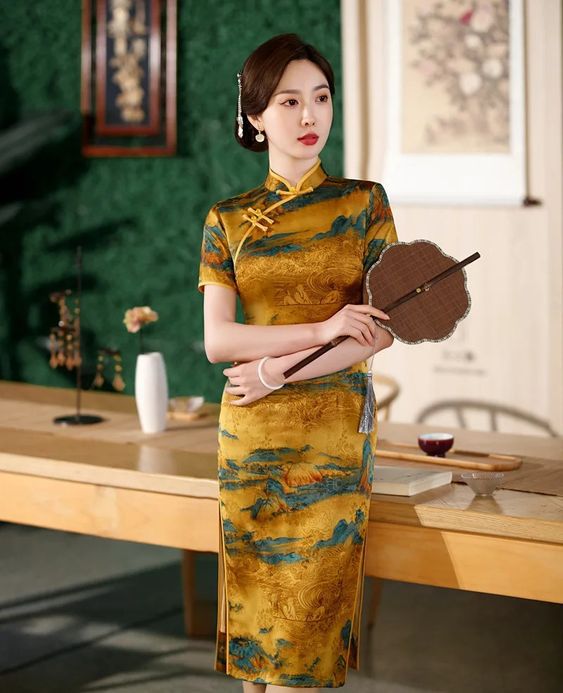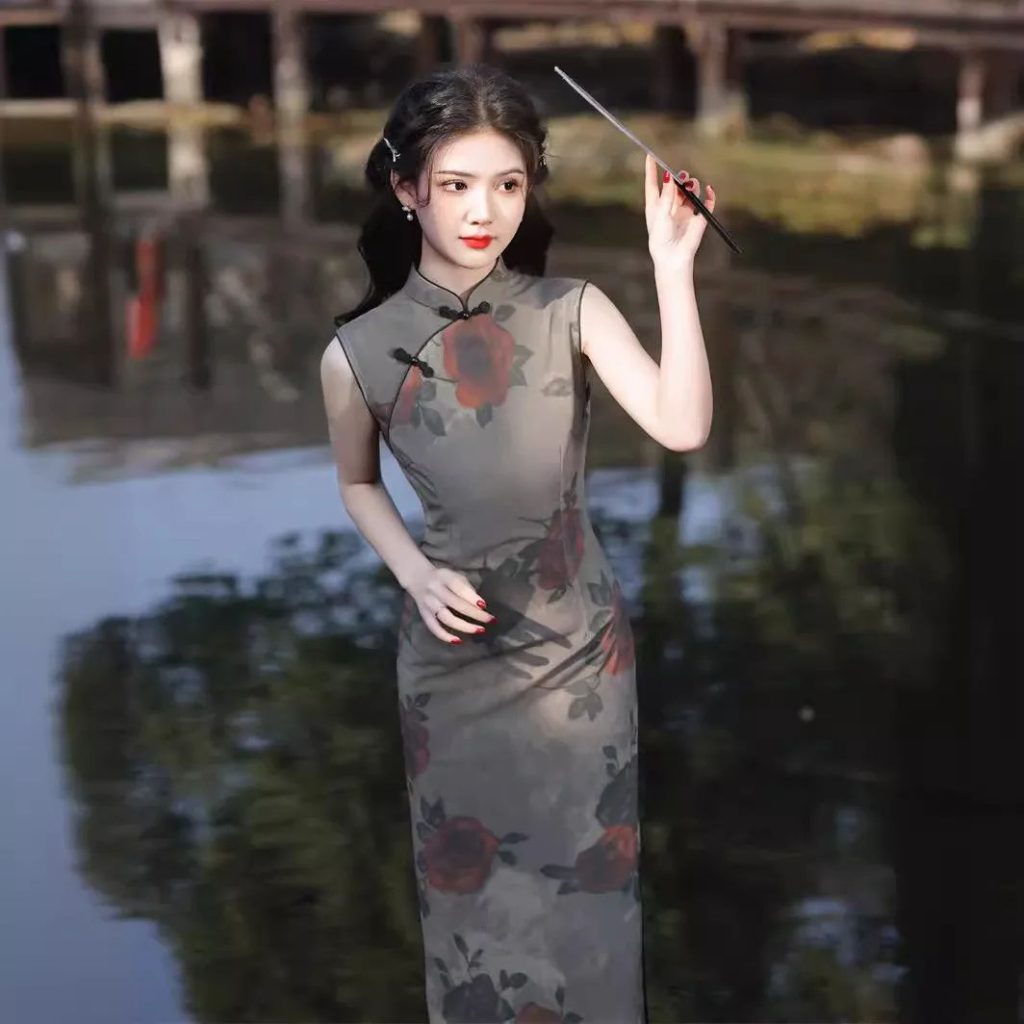The Evolution of Flower Patterns in Qipao Design
The qipao, a traditional Chinese dress, has undergone a remarkable evolution in its design, with flower patterns playing a pivotal role in shaping its aesthetic appeal. From its humble beginnings to its modern iterations, the application of flower patterns on qipao has mirrored the changing tastes and cultural influences of its time.

Early 20th Century Influences
In the early 20th century, qipao designs were heavily influenced by Western fashion, incorporating elements such as lace and embroidery. Flower patterns were often used as embellishments, adding a touch of femininity and elegance to the garment. As the qipao evolved into a symbol of Chinese identity, flower patterns became more prominent and symbolic.
Republican Era Motifs
During the Republican era, qipao designs embraced traditional Chinese motifs, including auspicious flowers such as peonies, plum blossoms, and chrysanthemums. These flowers represented virtues and qualities such as wealth, longevity, and purity. The placement of flower patterns also held significance, with auspicious flowers often adorning the front of the qipao, while less auspicious flowers were placed on the back.
Post-World War II Experimentation
In the post-World War II era, qipao designs became more experimental and eclectic. Flower patterns were combined with other elements, such as geometric shapes and abstract designs. The use of bold colors and unconventional flower arrangements created a more modern and avant-garde look.
Contemporary Qipao Designs
Contemporary qipao designs continue to draw inspiration from both traditional and modern sources. Flower patterns remain a popular choice, but they are often reinterpreted in new and innovative ways. Designers experiment with different fabrics, textures, and printing techniques to create unique and eye-catching designs.
Cultural Significance
The application of flower patterns on qipao has not only enhanced its aesthetic appeal but has also imbued it with cultural significance. Flower patterns have become an integral part of the qipao’s identity, reflecting the changing tastes and cultural influences of Chinese society. As the qipao continues to evolve, flower patterns will undoubtedly continue to play a vital role in shaping its design and appeal.
The Symbolism and Meaning of Flower Patterns on Qipao
The qipao, a traditional Chinese dress, has long been adorned with intricate flower patterns that hold profound cultural and symbolic significance. These patterns, often meticulously embroidered or printed, are not merely decorative elements but convey a wealth of meanings and messages.

Key Floral Motifs
The peony, known as the “king of flowers,” is a common motif on qipaos. Its lush petals symbolize prosperity, wealth, and honor. The lotus, with its ability to rise from murky waters, represents purity, resilience, and spiritual enlightenment. The plum blossom, blooming amidst winter’s chill, embodies perseverance, hope, and the triumph of adversity.
Other Symbolic Flowers
Chrysanthemums, with their vibrant hues, signify joy, longevity, and good fortune. Orchids, with their delicate beauty, represent elegance, refinement, and love. Butterflies, often depicted fluttering among flowers, symbolize freedom, transformation, and the pursuit of happiness.
Placement and Meaning
The placement of flower patterns on a qipao also carries symbolic meaning. Flowers blooming on the shoulders or sleeves suggest a woman’s beauty and grace. Patterns on the bodice represent her inner qualities, such as virtue, modesty, and intelligence. Flowers on the skirt symbolize her fertility and the hope for a prosperous future.
Personal Style Reflection
In addition to their symbolic meanings, flower patterns on qipaos also reflect the wearer’s personal style and preferences. Some women opt for bold and vibrant patterns that exude confidence and vitality, while others prefer more subtle and delicate designs that convey elegance and sophistication.
Cultural Heritage
The application of flower patterns on qipaos is a testament to the rich cultural heritage of China. These patterns not only enhance the beauty of the garment but also convey a wealth of meanings and messages that have been passed down through generations. By understanding the symbolism and significance of these patterns, we can appreciate the depth and complexity of Chinese culture and its enduring influence on fashion and art.
Modern Interpretations of Flower Patterns on Qipao
The qipao, a traditional Chinese dress, has undergone a resurgence in popularity in recent years, with designers reimagining its classic silhouette and incorporating modern elements. One notable trend has been the application of flower patterns on qipao, adding a touch of femininity and elegance to the garment.

Cultural and Symbolic Meanings
Historically, flower patterns have held significant cultural and symbolic meanings in Chinese art and fashion. Peonies, for instance, represent prosperity and good fortune, while lotus flowers symbolize purity and enlightenment. By incorporating these motifs into qipao designs, contemporary designers pay homage to Chinese heritage while infusing the garment with a fresh and contemporary aesthetic.
Innovative Techniques
The application of flower patterns on qipao is not limited to traditional embroidery techniques. Designers have experimented with various methods, including digital printing, laser cutting, and beading, to create intricate and eye-catching designs. These techniques allow for a wider range of colors, textures, and patterns, enabling designers to cater to diverse tastes and preferences.
Versatility of Flower Patterns
One of the key advantages of using flower patterns on qipao is their versatility. They can be incorporated into both formal and casual designs, making the garment suitable for a variety of occasions. For formal events, qipao with elaborate floral embroidery or beading can create a sophisticated and glamorous look. Conversely, qipao with simpler floral prints or laser-cut designs can be dressed down for more casual settings.
Color Palettes and Seasonal Elements
Furthermore, flower patterns offer designers the opportunity to explore different color palettes and create visually striking garments. By combining vibrant hues with delicate pastels or contrasting colors, designers can create qipao that are both eye-catching and flattering. The use of floral motifs also allows for the incorporation of seasonal elements, such as cherry blossoms in spring or chrysanthemums in autumn, adding a touch of nature and timeliness to the designs.
Conclusion
In conclusion, the application of flower patterns on qipao has become a significant trend in modern interpretations of the traditional Chinese dress. By incorporating these motifs into their designs, contemporary designers not only pay homage to Chinese heritage but also create garments that are both stylish and versatile. The use of various techniques and color palettes allows for a wide range of designs, catering to diverse tastes and preferences. As the qipao continues to evolve, flower patterns will undoubtedly remain a key element in its modern interpretations, adding a touch of femininity, elegance, and cultural significance to this iconic garment.
